Study on modulation techniques for downlink chanel in Li-Fi
Abstract: Light-Fidelity (Li-Fi) is considered as a fully optical networked communication
with the capability of bidirectional transmission. Li-Fi is a subset of Visible Light
Communications (VLC) using visible light to modulate mobile data which offer many
advantages in indoor environment. This paper is aimed to provide a comprehensive
knowledge to the available modulation techniques which is utilized for downlink channel
in VLC networks and particularly in Li-Fi. These modulation schemes are clarified and
then grouped for the clearly and throughout vision in the paper. Advantages and
disadvantages of them are also given out adequately and compared to each other.
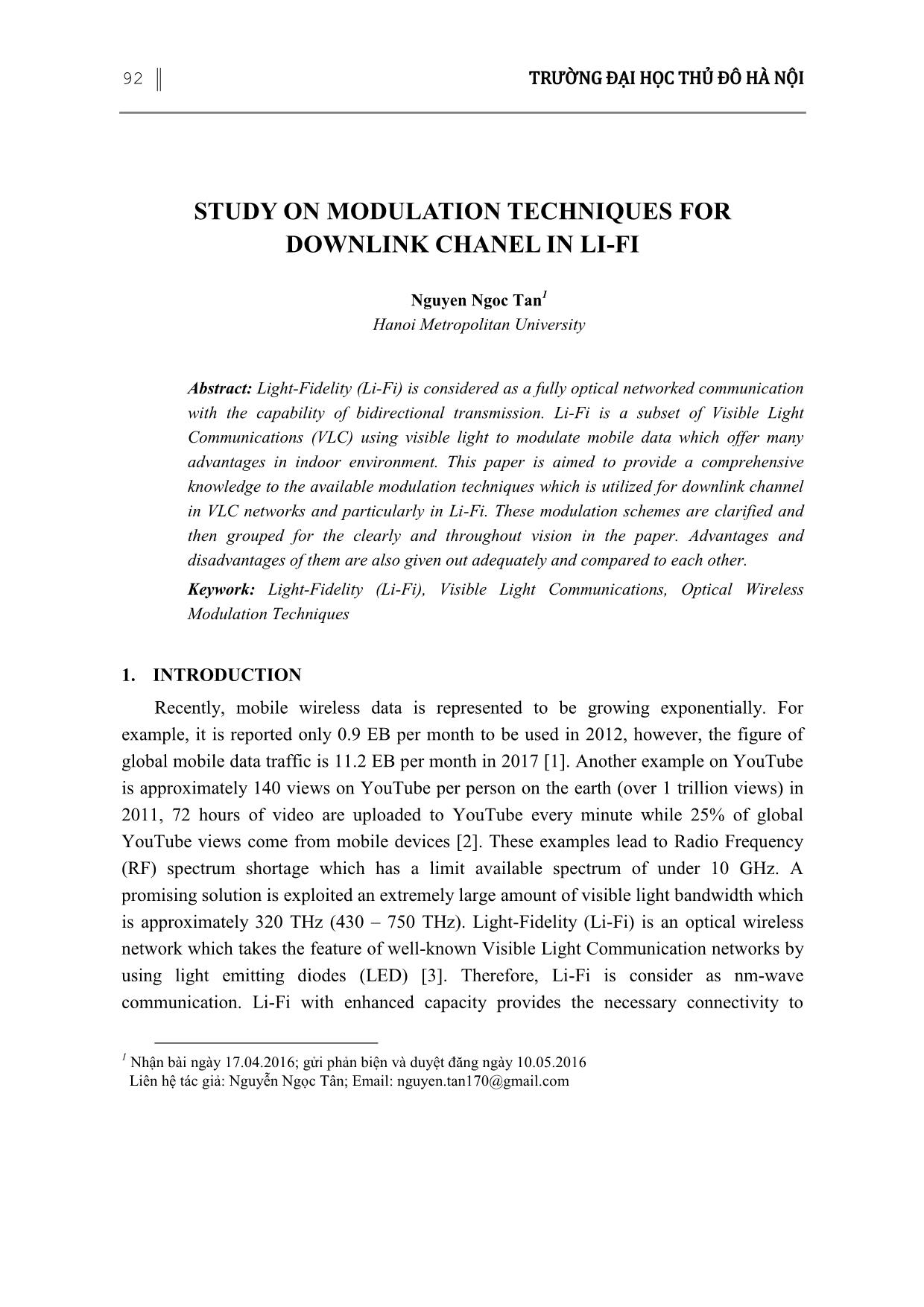
Trang 1
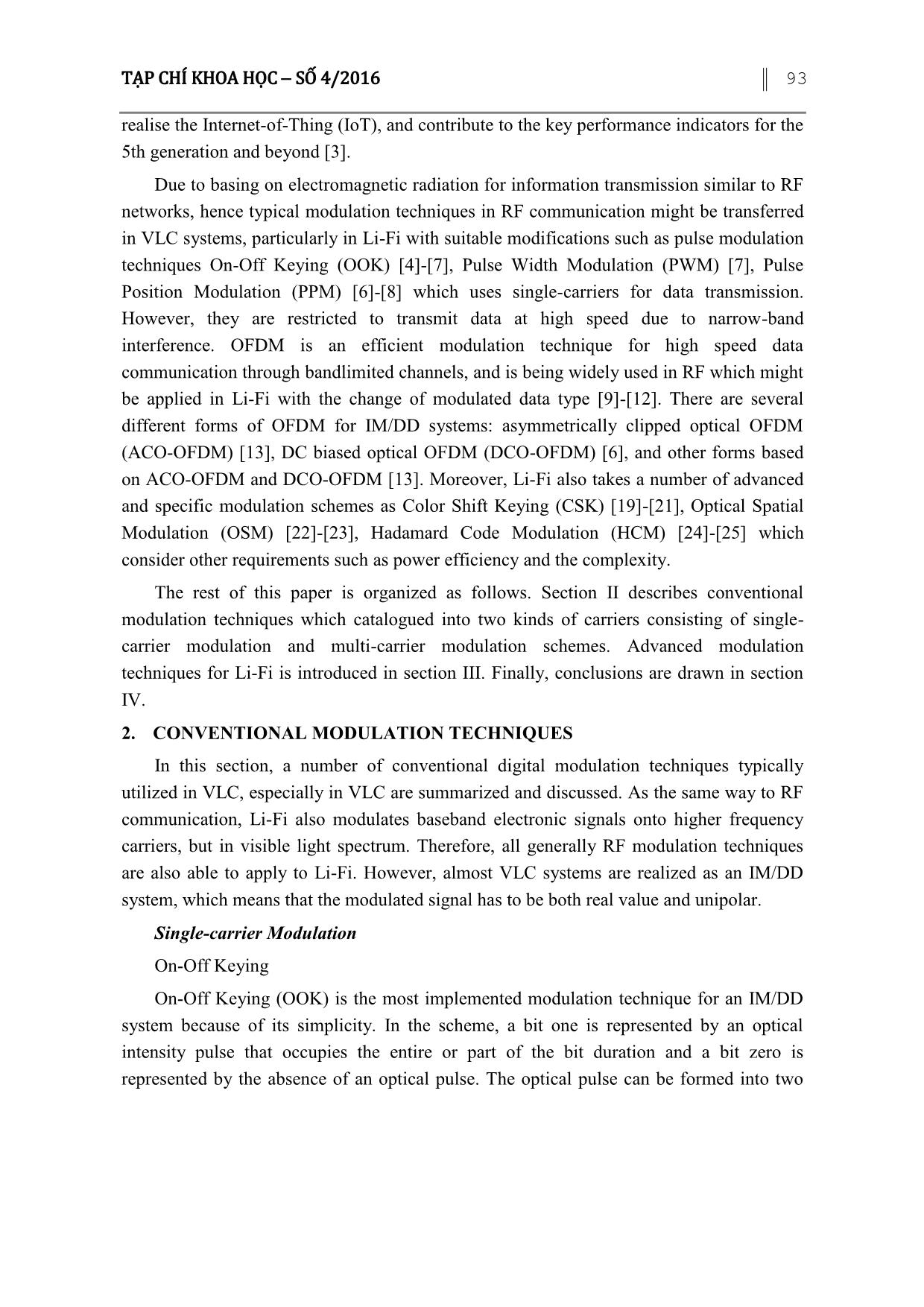
Trang 2
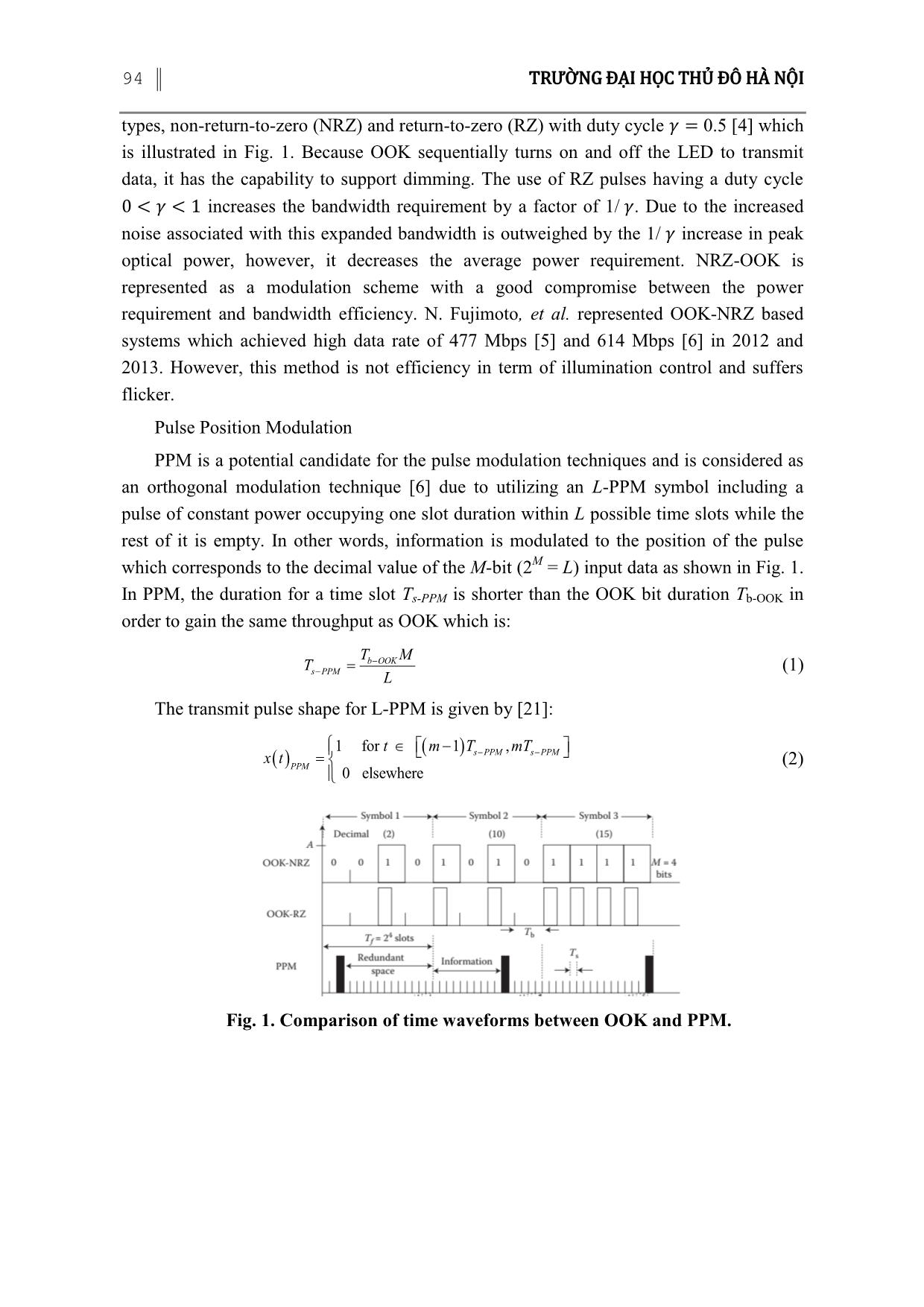
Trang 3
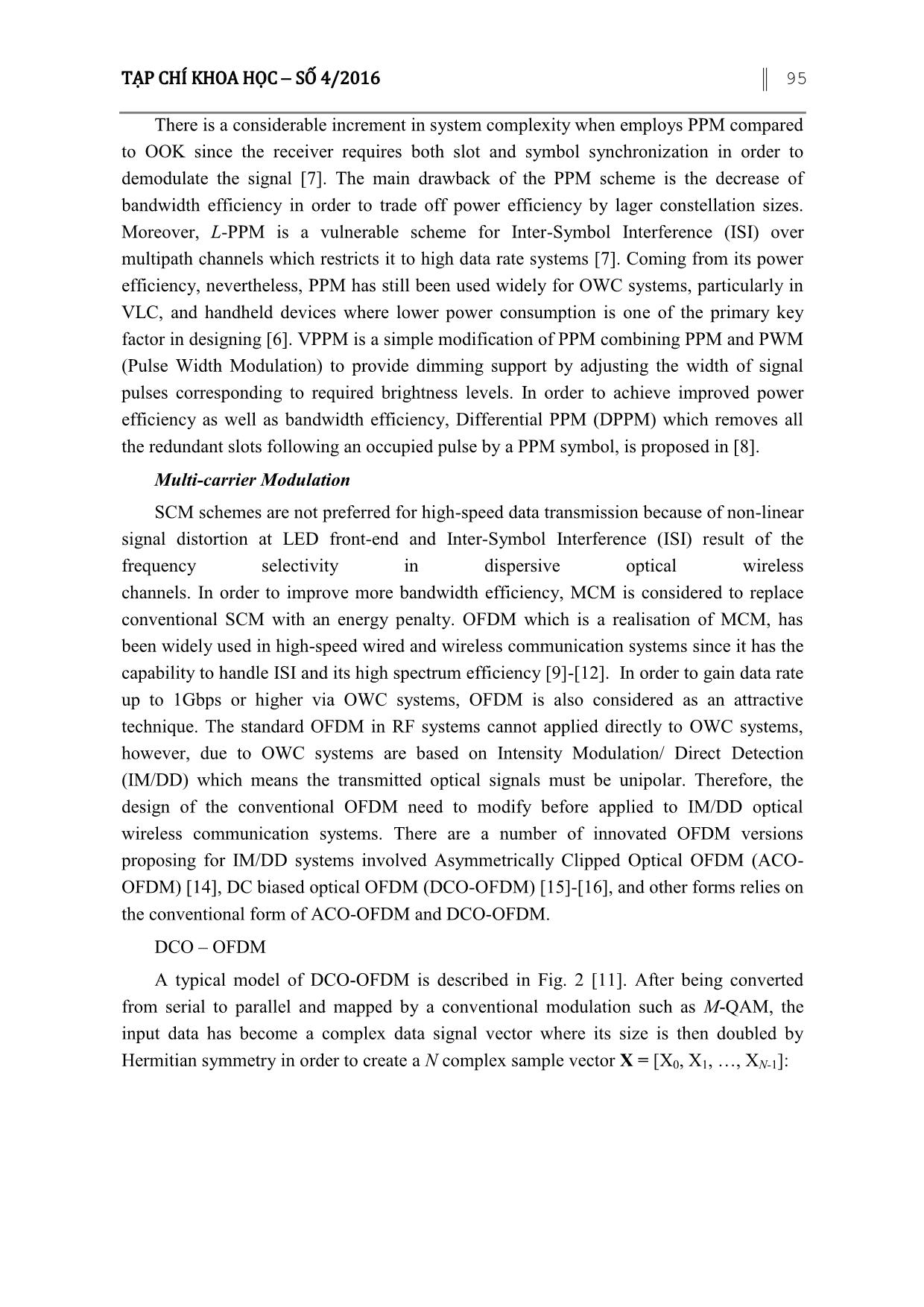
Trang 4
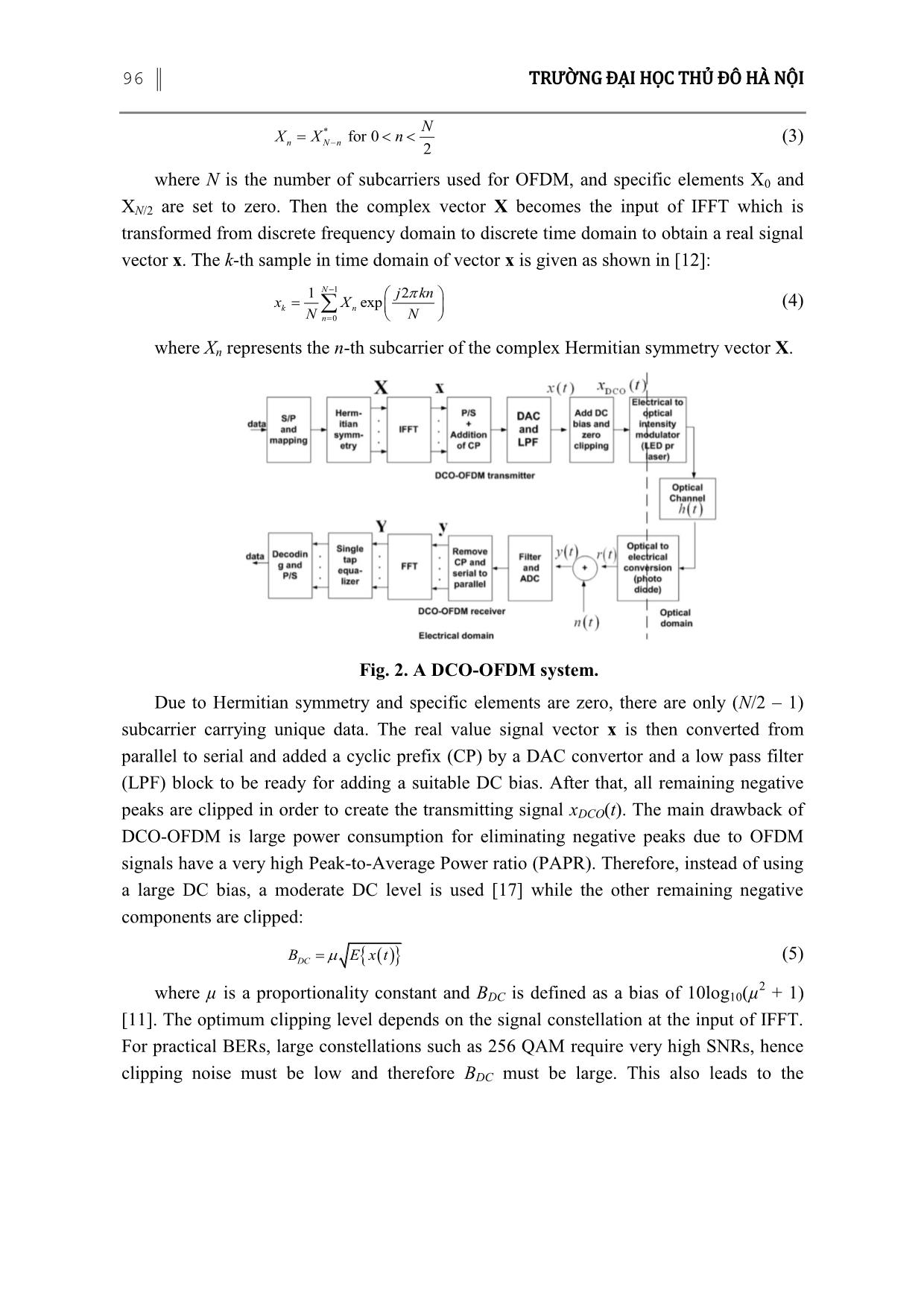
Trang 5
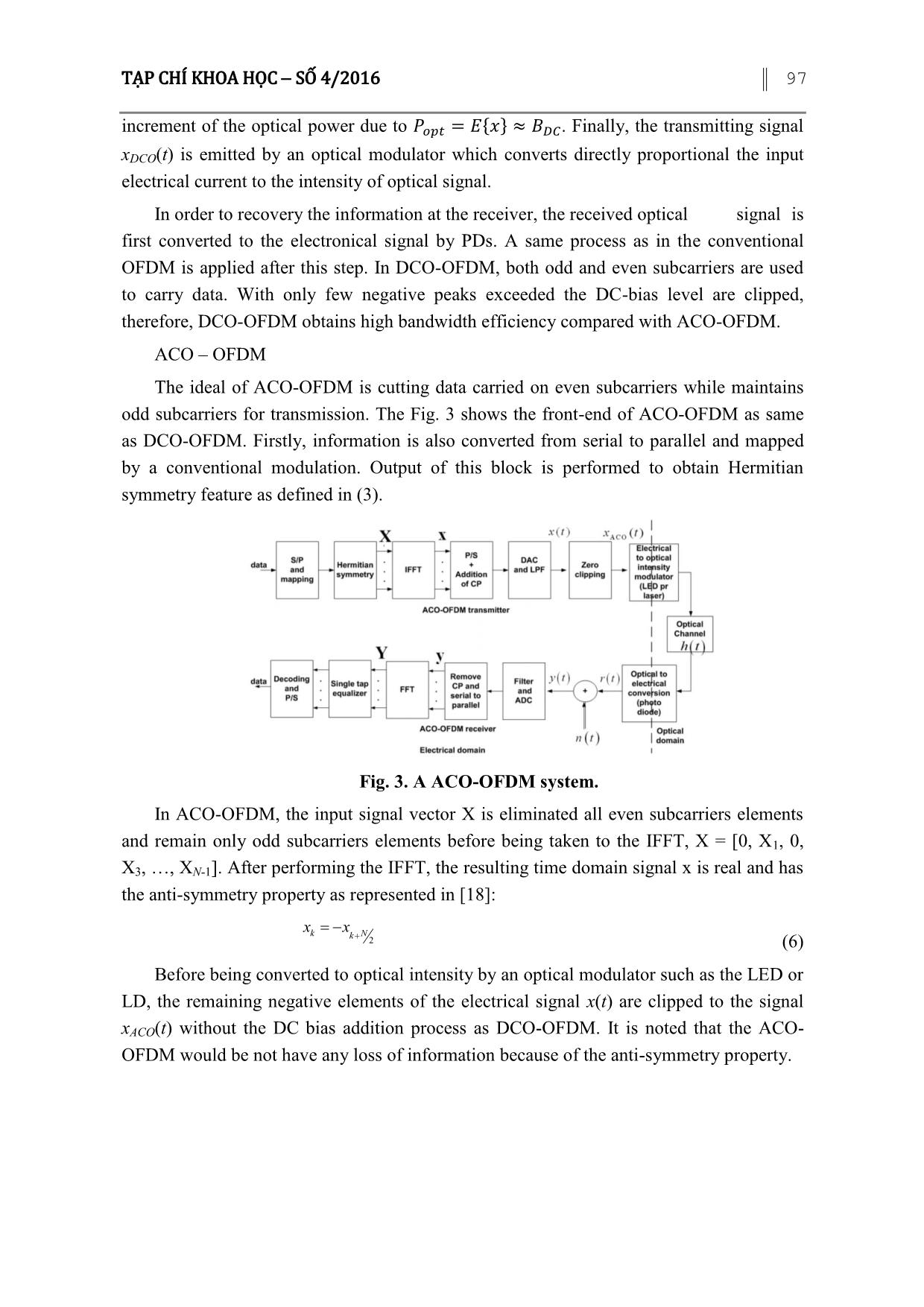
Trang 6
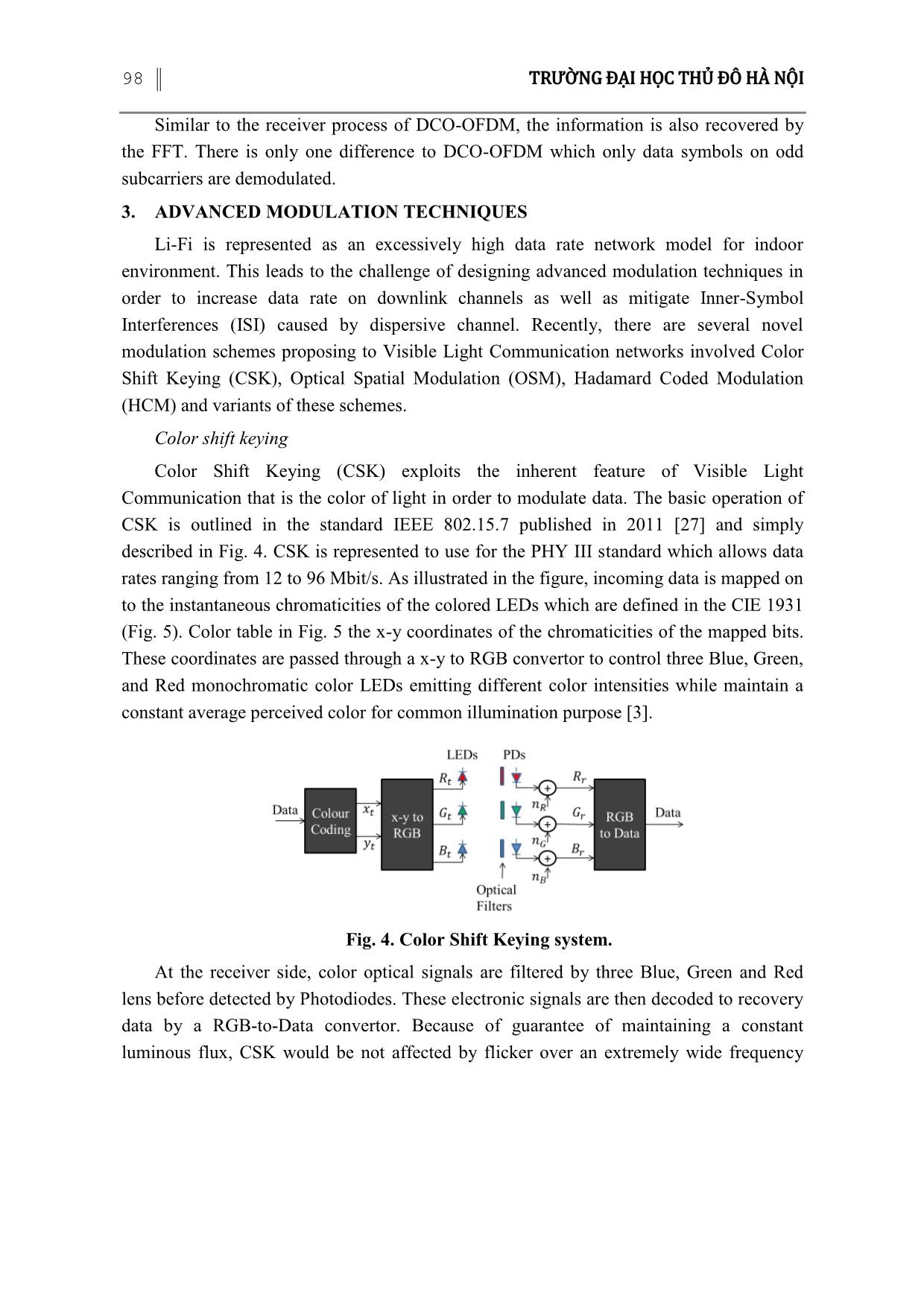
Trang 7
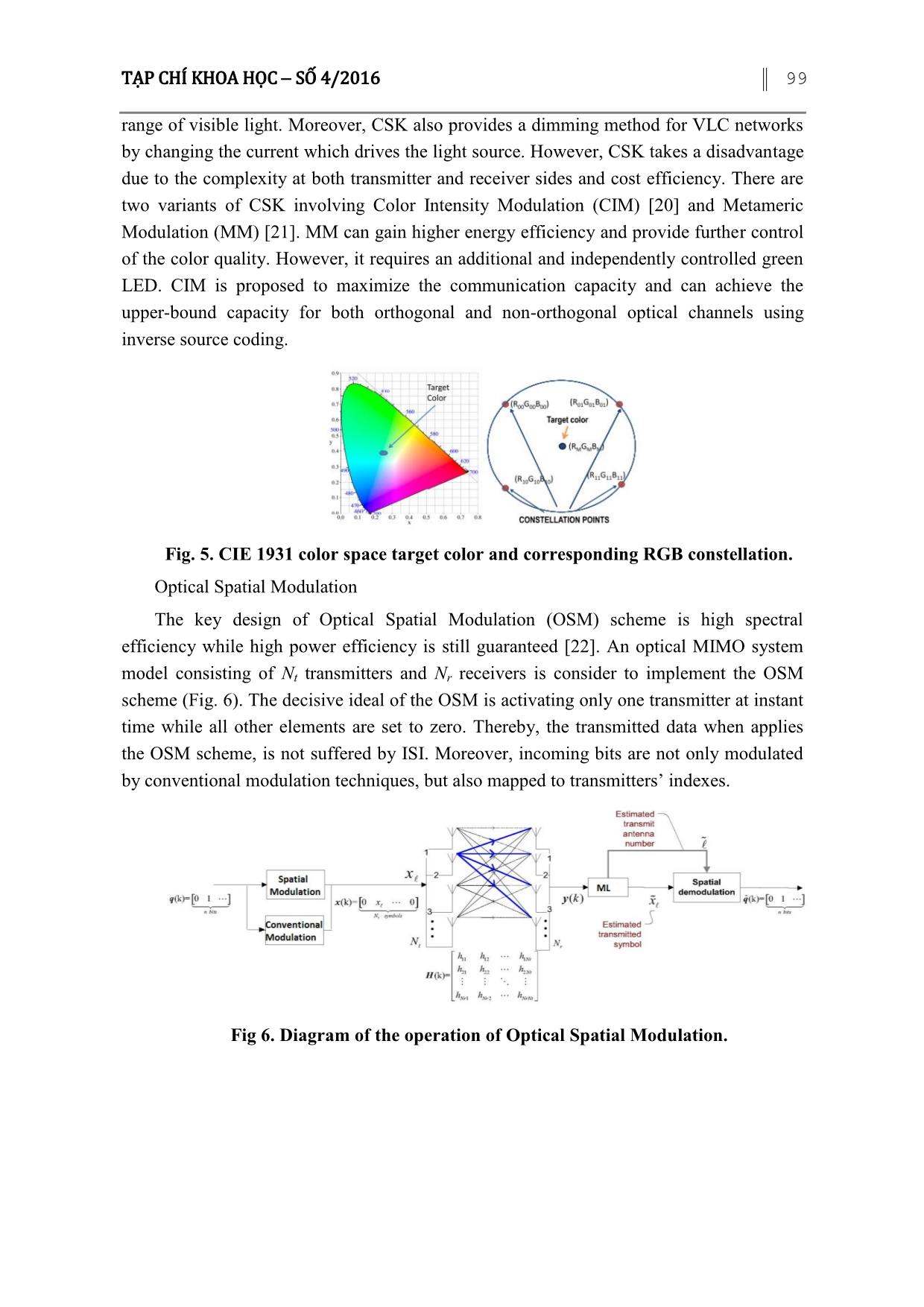
Trang 8

Trang 9

Trang 10
Tải về để xem bản đầy đủ
Tóm tắt nội dung tài liệu: Study on modulation techniques for downlink chanel in Li-Fi

) bit/s/Hz.
Fig 7. Illustration of mapping binary data to transmitters’ indexes.
At the receiver side, an optimal SM detector is utilized to estimate the signal vector
̂(k) from the electronic signal converted from the received optical signal by Photodiodes
(PDs) [28]. The estimation is relied on the Maximum-Likelihood (ML) principle which
decides the estimated signal vector ̂ by minimizing the Euclidean distance between the
actual received signal y and all potential received signals:
2
F
ˆ argmax ( , ) argmin
x
p x H H
y
x
x y y x (8)
where py is the probability density distribution of the received signal y conditioned on
the transmitted signal x and the channel matrix H. It is clearly seen that OSM do not only
achieve higher data rate over conventional modulations and mitigate ISI, but also it
addresses the power efficiency by the requirement of activating only one transmitter at
instant time compared to other MIMO models. Comparison to OOK modulation, OSM
achieves Bit Error Rate (BER) slightly better. Another factor is also considered is
computational complexity at the receiver. OSM requires fewer mathematical operations
than Repetition Coding (RC) in order to detect transmitted data [18]. It takes only 3MNr
TẠP CHÍ KHOA HỌC SỐ 4/2016 101
operations, while is the operations required by RC. By using the
transmitters‟ indexes for data modulation, however, Bit Error Rate (BER) of OSM is
affected by coherence among transmitters (LEDs). It means that the distances between
LEDs must be sufficiently far in order to guarantee estimating exactly what LED is used to
transmit data at instant time. Beside, OSM offers only a logarithmic increase of the data
rate with the number of transmitters. This might limit OSM to be implemented for practical
number of LEDs using for illumination in any room. The last disadvantage of OSM is
channel knowledge which must be well known for data detection, it might lead complexity
constraints on the channel estimation unit [29]. From the perspective of increasing spectral
efficiency, Generalized Spatial Modulation (GSM) in VLC is also proposed in [30].
Instead of fixing the number of transmitter as an exponential of two, GSM is a generalized
form of SM which actives Na (0 < Na < Nt) transmitters simultaneously at any time. Hence,
the data rate of GSM is increased as following:
2 2log log
t
GSM a
a
N
N M
N
(9)
Another application of SM is proposed in [31] to obtain positive and real-valued
signals for OFDM in VLC. The proposed method solves the DC-bias problem in DCO-
OFDM and get a higher spectral efficiency than ACO-OFDM [31] called NDC-OFDM.
The authors added a SM mapper behind the IFFT block to separate positive and negative
value OFDM signals into two LED transmitters. In other words, the sign of the OFDM
symbols is represented by the index of the corresponding LED.
Hadamard Coded Modulation
OFDM is represented as a high-dimensional modulation technique for high data-rate
transmission that has been widely adapted to many modern broadband communications
and standards, however, suffer source, channel and amplifier nonlinearities due to its high
peak-to-average ratio (PAPR) [24]. OFDM signals with large peaks are then clipped by the
peak optical power constraint of the optical sources. In VLC systems, due to high average
optical powers are required for illumination, some symbols of OFDM might suffer for
signal clipping [25]. Mohammad Noshad, et al. are introduced an alternative modulation
technique to OFDM called Hadamard Code Modulation (HCM) which uses the fast Walsh-
Hadamard transform (FWHT) to modulate data. The proposed modulation scheme uses
binary Hadamard matrixes to encode the input data stream, which has the same complexity
as the FFT in OFDM, Nlog2 N, where N is the size of the Hadamard matrix. HCM achieves
a same BER compared to OFDM, while can provide brighter illumination levels for VLC
systems because of its low PAPR.
102 TRƯỜNG ĐẠI HỌC THỦ ĐÔ HÀ NỘI
Fig. 8. Block diagram of the HCM transmitter using FWHT
A Hadamard matrix of order N which is modified by replacing 0 for -1 elements in the
original {-1, 1} Hadamard matrix [32], is denoted by HN. The transmitted vector x is
obtained from the input data vector as shown below:
1
x (1 )N N
N
uH u H (10)
where
NH is the complement of NH . The components of the signal vector u are
assumed being modulated signal by a M-ary Pulse Amplitude Modulation (PAM), where
{
} . The equation (10) is then rewritten as
following:
1
x 0,1,1,...,1
2
N N
N
N
u H H (8)
Only N-1 rows of the matrix HN which have a weight of N/2, are used to modulate
data, while the first row of the Hadamard matrix which all values are one, is ignored.
Hence the first row is set to zero and the rate of M-PAM HCM is . The
interference of the Hadamard codewords on each other due to the fixed cross correlation
between these remaining N − 1 rows can be removed at the receiver side [33]. The received
signal is given by:
y h x n (11)
where n is assumed an additive white Gaussian noise (AWGN) and h is the discrete
time equivalent impulse response of the channel which h = {h(k)}. The vector y is then
demodulated to the vector v by an inverse FWHT (IFWHT) as shown in Fig. 9:
1 T T
N N
N
v yH yH (12)
TẠP CHÍ KHOA HỌC SỐ 4/2016 103
Fig. 9. Block diagram of the HCM receiver using IFWHT
For an ideal non-dispersive channel with impulse response as defined in [24]:
1 0
0 0
k
h k
k
(13)
The decoded data can be rewritten as following:
1
1,1,1,....,1
2
N
v u n (14)
where
1 T T
N N
N
n = n H H is a 1 × N noise vector with independent components. The
BER of M-PAM HCM for non-dispersive AWGN channels can be calculated from (34):
2
2 22
2
1 3
BER
log 1
HCM
N clip
PM NQ
M M M
(15)
where γ represents the penalty in SNR due to the pulse shaping, 2
N is the variance of
the additive Gaussian noise at the receiver and 2
clip is the variance of the clipping noise.
The author is also introduced an improved version of HCM which reduces the DC bias
without losing information. A DC bias value bDC is added to the transmitted signal, then
the decoded vector becomes:
,0,...,0 1DCNb
v u n - (16)
It is clearly shown that the DC bias is only added to the first component of the
transmitted signal and has no effect on the rest of the data. The BER comparison between
ACO-OFDM using 16-QAM to modulate 128 subcarriers and HCM signals are generated
by an FWHT size N = 128 are realised in [17]-[18]. As a result, HCM achieves lower BER
for average optical powers higher than 18 dBm and 20.3 dBm for 2
n = −30 dBm and
2
n =
−20 dBm, respectively. Both HCM and DCR-HCM shows the capability to gain a lower
104 TRƯỜNG ĐẠI HỌC THỦ ĐÔ HÀ NỘI
achievable BER for all spectral efficiencies tested when are compared to ACO-OFDM and
DCO-OFDM [25].
4. CONCLUSION
Li-Fi with great applications makes itself to become a potential candidate for the
architecture of the 5G network. The hottest topic attracted the most researches on it is data
modulation. The three primary keys for modulation techniques considered in Li-Fi are the
complexity, spectral and power efficiency. Through the paper, all available modulation
schemes for Li-Fi are represented and compared the benefits and also shortages of each
technique relied on these factors.
5. ACKNOWLEGMENT
I am very much grateful for the help of Department of Information Technology –
Hanoi Metropolitan University and members which fully support me to implement this
research.
REFERENCES
1. R. Pepper (2013), “Cisco Visual Networking Index (VNI) Global Mobile Data Traffic Forecast
Update 2012-2017”, Mobile World Congress.
2.
3. H. Haas, Y. Wang and C. Chen (2016), “What is LiFi?”, Journal of Lightwave Technology,
vol. 34, pp.1533-1544.
4. J. M. Kahn, and J. R. Barry (1997), “Wireless infrared communications”, Proceedings of the
IEEE, vol. 85, pp.265-298.
5. N. Fujimoto and H. Mochizuki (2013), “477 mbit/s visible light transmission based on ook-nrz
modulation using a single commercially available visible led and a practical led driver with a
pre-emphasis circuit”, Optical Fiber Communication Conference and Exposition and the
National Fiber Optic Engineers Conference (OFC/NFOEC), pp.1-3, Anaheim, California,
USA.
6. N. Fujimoto and H. Mochizuki (2012), “614 mbit/s ook-based transmission by the duo-binary
technique using a single commercially available visible led for high-speed visible light
communications”, in European Conference and Exhibition on Optical Communication
(ECEOC). Amsterdam Netherlands: Optical Society of America.
7. Z. Ghassemlooy, W. Popoola, and S. Rajbhandari (2013), “Optical Wireless Communications:
System and Channel Modelling with MATLAB”, CRC Press.
8. D. Shiu and J. M. Kahn (1999), “Differential pulse position modulation for power-efficient
optical communication”, IEEE Transactions on Communication, vol. 47, pp.1201-1210.
9. J. Armstrong (2009), “OFDM for Optical Communications”, Journal of Lightwave
Technology, vol. 27, pp.189-204.
TẠP CHÍ KHOA HỌC SỐ 4/2016 105
10. O. Gonzalez, R. Perez-Jimenez, S. Rodriguez, J. Rabadan, and A. Ayala (2005), “OFDM over
indoor wireless optical channel”, IEE Proceedings – Optoelectronics, vol. 152, pp.199-204.
11. S. D. Dissanayake, and J. Armstrong (2013), “Comparison of ACO-OFDM, DCO-OFDM and
ADO-OFDM in IM/DD Systems”, Journal of lightwave technology, vol. 31, pp. 1063-1072.
12. R. Hassan, and F. T. Z. Tuli (2015), “Analysis of ACO-OFDM, DCO-OFDM and Flip-OFDM
for IM/DD optical-wireless and optical-fiber system”, IEEE International Conference on
Telecommunications and Photonics (ICTP), Dhaka, Bangladesh.
13. S. D. Dissanayake, K. Panta, and J. Armstrong (2011), “A novel technique to simultaneously
transmit ACO-OFDM and DCO-OFDM in IM/DD systems”, in Proc. IEEE GLOBECOM
Workshops, pp.782-786, Houston, TX, USA.
14. J. Armstrong and A. J. Lowery (2006), “Power efficient optical OFDM”, Electron. Lett, vol.
42, pp.370-372.
15. K. Asadzadeh, A. Dabbo, and S. Hranilovic (2011), “Receiver design for asymmetrically
clipped optical OFDM”, in Proc. IEEE GLOBECOM OWC Workshop, Houston, TX, USA.
16. S. C. J. Lee, F. Breyer, D. Cardenas, S. Randel, and A. M. J. Koonen (2009), “Real-time
gigabit DMT transmission over plastic optical fibre”, Electron. Lett, vol. 45, pp.1342-1343.
17. J. Armstrong, and B. J. C. Schmidt (2008), “Comparison of Asymmetrically Clipped Optical
OFDM and DC-Biased Optical OFDM in AWGN”, IEEE Communications Letters, vol. 12,
pp.343-345.
18. K. Asadzadeh, A. Dabbo, and S. Hranilovic (2011), “Receiver design for asymmetrically
clipped optical OFDM”, IEEE GLOBECOM Workshops (GC Wkshps), pp.777-781, Houston,
TX.
19. F. A. Delgado Rajó, V. Guerra, J. A. Rabadán Borges, J. R. Torres and R. Pérez-Jiménez
(2014), “Color Shift Keying Communication System With a Modified PPM Synchronization
Scheme”, IEEE Photonics Technology Letters, vol. 26, pp.1851-1854.
20. K. I. Ahn, and J. K. Kwon (2012), “Color Intensity Modulation for Multicolored Visible Light
Communications”, IEEE Photonics Technology Letters, vol.24, pp.2254-2257.
21. P. M. Butala, J. C. Chau, and T. D. C. Little (2012), “Metameric modulation for diffuse visible
light communications with constant ambient lighting”, 2012 International Workshop on
Optical Wireless Communications (IWOW), Paris.
22. Raed Mesleh, Hany Elgala, and Harald Haas (2011), “Optical Spatial Modulation”, IEEE/OSA
Journal of Optical Communications and Networking, vol. 3, pp.234-244.
23. Thilo Fath, Harald Haas, Marco Di Renzo and Raed Mesleh (2011), “Spatial Modulation
applied to Optical Wireless Communications in Indoor LOS Environments”, 2011 IEEE
Global Telecommunications Conference (GLOBECOM 2011), Houston, TX, USA.
24. M. Noshad, and M. Brandt-Pearce (2014), “Hadamard coded modulation: An alternative to
OFDM for wireless optical communications”, 2014 IEEE Global Communications Conference
(GLOBECOM), pp.2102-2107, Austin.
106 TRƯỜNG ĐẠI HỌC THỦ ĐÔ HÀ NỘI
25. M. Noshad, and M. Brandt-Pearce (2016), “Hadamard Coded Modulation for Visible Light
Communications”, IEEE Transactions on Communications, vol. 64, pp.1167-1175.
26. K. Sato and K. Asatani (1981), “Speckle noise reduction in fiber optic analog video
transmission using semiconductor laser diodes”, IEEE Transactions on Communications, 29,
pp.1017-1024.
27. IEEE Std. 802.15.7-2011, IEEE Standard for Local and Metropolitan Area Networks, Part
15.7: Short-Range Wireless Optical Communication Using Visible Light, IEEE Std.
28. J. Jeganathan, A. Ghrayeb, and L. Szczecinski (2008), “Spatial Modulation: Optimal Detection
and Performance Analysis”, IEEE Communications Letters, vol. 12, pp.545-547.
29. Ekta balotra and Koushik Barman (2013), “Spatial Modulation”, International Journal of
Engineering Research & Technology, vol. 2.
30. S. P. Alaka, T. Lakshmi Narasimhan, and A. Chockalingam (2015), “Generalized Spatial
Modulation in Indoor Wireless Visible Light Communication”, 2015 IEEE Global
Communications Conference (GLOBECOM), San Diego.
31. Y. Li, D. Tsonev, and H. Haas (2013), “Non-DC-biased OFDM with Optical Spatial
Modulation”, 2013 IEEE 24th International Symposium on Personal Indoor and Mobile Radio
Communications (PIMRC), pp.486-490, London.
32. K. J. Horadam (2006), “Hadamard Matrices and Their Applications”, Princeton University
Press.
33. M. Noshad, M. Brandt-Pearce (2012), “Expurgated PPM Using Symmetric Balanced
Incomplete Block Designs”, IEEE Communications Letters, vol. 16, pp.968-971.
34. K. Cho and D. Yoon (2002), “On the general BER expression of one and two dimensional
amplitude modulations”, IEEE Transaction Communications, vol. 50, pp.1074-1080.
NGHIÊN CỨU CÁC KỸ THUẬT ĐIỀU CHẾ CHO KÊNH ĐƯỜNG XUỐNG
TRONG MẠNG LI-FI
Tóm tắt: Light-Fidelity (Li-Fi) được xem như một mô hình mạng không dây quang hoàn
chỉnh với khả năng truyền song công. Li-Fi là một trường hợp riêng của mạng truyền
thông sử dụng ánh sáng nhìn thấy (VLC) sử dụng ánh sáng nhìn thấy để điều chế tín hiệu
di động. Nó đạt được rất nhiều lợi ích trong môi trường truyền thông trong nhà. Mục tiêu
của bài báo là cung cấp kiến thức về các kỹ thuật điều chế có thể sử dụng cho kênh
đường xuống trong mạng VLC, và mạng Li-Fi nói riêng. Các cơ chế điều chế này được
phân loại và nhóm lại nhằm cung cấp một cái nhìn rõ ràng và xuyên suốt trong toàn bộ
bài báo. Ngoài ra, các ưu điểm và hạn chế của các kỹ thuật điều chế trên cũng được đưa
ra và so sánh với nhau.
Từ khóa: Light-Fidelity (Li-Fi), Mạng truyền thông sử dụng ánh sáng nhìn thấy, Các kỹ
thuật điều chế trong mạng quang không dây.
File đính kèm:
 study_on_modulation_techniques_for_downlink_chanel_in_li_fi.pdf
study_on_modulation_techniques_for_downlink_chanel_in_li_fi.pdf

